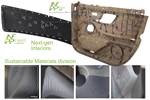SeaBioComp project develops biocomposite demonstrator products for marine applications
Prototype products explore thermoplastic polymers, natural fibers and 3D printing technologies to effectively reduce the use of fossil-based materials in the marine sector.

Demonstrator products produced through SeaBioComp. Photo Credit: SeaBioComp
SeaBioComp, a collaborative project that aims to develop and produce novel bio-based composite materials to replace conventional oil-based products in the maritime industry, has successfully produced a number of demonstrator products for the marine environment — using different manufacturing processes — to showcase its flax-based thermoplastic biocomposites.
The project is co-funded under the EU Interreg 2 seas program, within the Technical Innovation theme, and the European Regional Development Fund. SeaBioComp runs from March 2019 to February 2023 with an overall budget of €4.1 million.
Project partners, including research organizations, textile and composite specialists, universities and cluster organizations, have been working together for the past three years to develop, mechanically test and research a number of bio-based formulations using different manufacturing techniques.
From these efforts, two different kinds of biocomposites have been developed; a self-reinforced poly lactic acid (PLA) composite which has been made into a variety of nonwoven and woven fabrics suitable for use in compression molding, and a flax fiber-reinforced PLA or acrylic (PMMA)-reinforced composite for use via RIFT, compression molding and additive manufacturing (AM).
Extensive testing of the biocomposites’ mechanical properties has concluded that these materials are close to, and in some instances, perform better than conventional non-bio-based composites (eg., sheet molded composite/SMC) currently used in the marine environment today. The new bio-based products have been shown to use the same compression molding conditions as conventional products and sometimes the process cycle time can be shorter.
The project has shown that the combination of thermoplastic polymers, natural fibers and 3D printing technologies can result in technically complex designs and applications for marine applications. A number of initial prototype products, including a fender and other port structures have successfully been produced using 3D printing, as well as scale-model offshore wind turbine blades manufactured via monomer infusion under flexible tooling (MIFT) and complex-curved structures using compression molding techniques
The project has released a series of technical leaflets detailing the various production methods using self-reinforced biocomposites and flax-based biocomposites for marine applications, including compression molding, monomer infusion and AM. Leaflets can be downloaded here.
In addition, the project has also determined whether these bio-based self-reinforced PLA (SRPLA) products are suitable for use in the marine environment from a durability and microplastic formation perspective. A new paper, published in Polymer Testing, discusses the potential for SRPLA to be considered a promising material for sustainable marine applications.
Related Content
-
The potential for thermoplastic composite nacelles
Collins Aerospace draws on global team, decades of experience to demonstrate large, curved AFP and welded structures for the next generation of aircraft.
-
Sulapac introduces Sulapac Flow 1.7 to replace PLA, ABS and PP in FDM, FGF
Available as filament and granules for extrusion, new wood composite matches properties yet is compostable, eliminates microplastics and reduces carbon footprint.
-
A new era for ceramic matrix composites
CMC is expanding, with new fiber production in Europe, faster processes and higher temperature materials enabling applications for industry, hypersonics and New Space.















